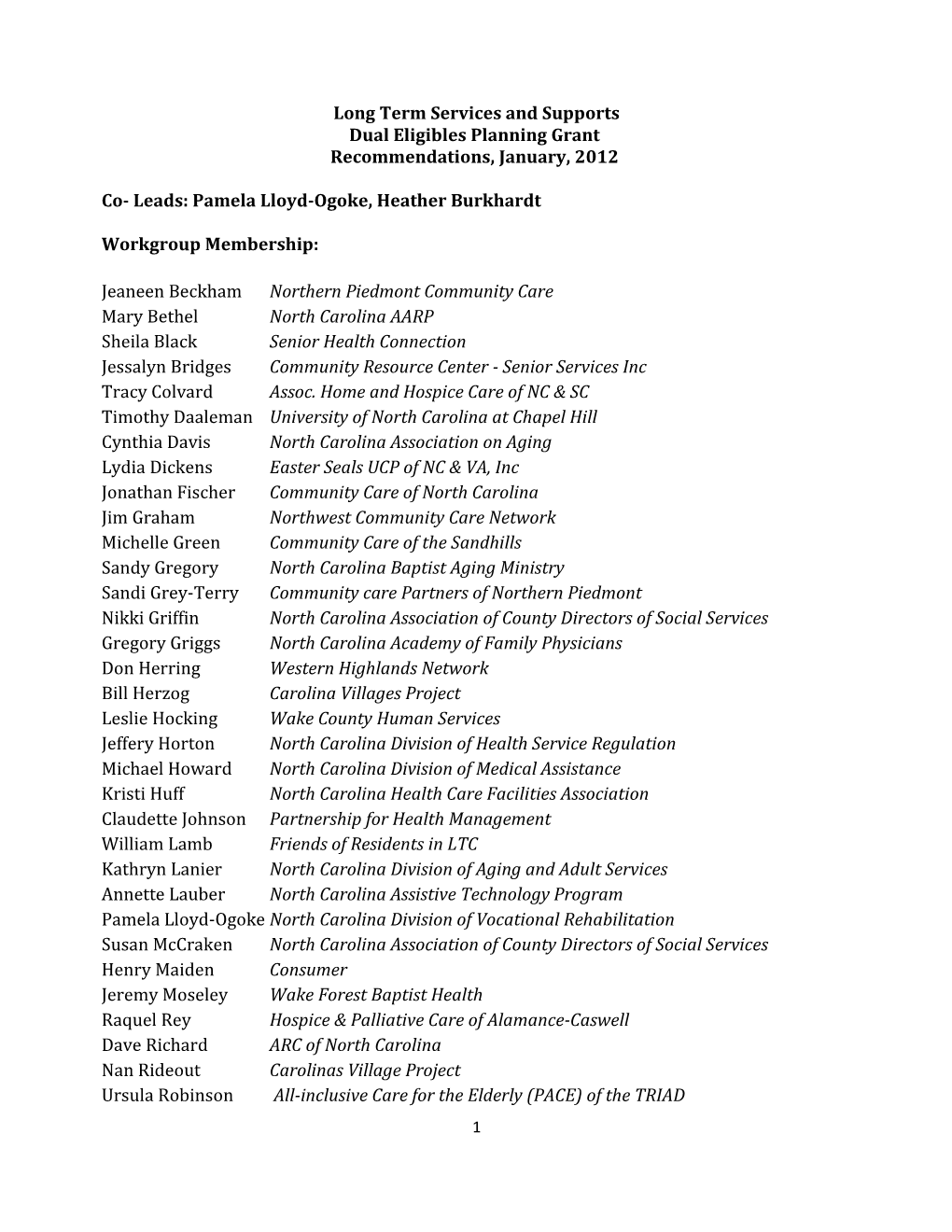Long Term Services and Supports
Dual Eligibles Planning Grant
Recommendations, January, 2012
Co- Leads: Pamela Lloyd-Ogoke, Heather Burkhardt
Workgroup Membership:
Jeaneen BeckhamNorthern Piedmont Community Care
Mary BethelNorth CarolinaAARP
Sheila BlackSenior Health Connection
Jessalyn BridgesCommunityResourceCenter - Senior Services Inc
Tracy ColvardAssoc. Home and Hospice Care of NC & SC
Timothy DaalemanUniversity of North Carolina at Chapel Hill
Cynthia DavisNorth CarolinaAssociation on Aging
Lydia DickensEaster Seals UCP of NC & VA, Inc
Jonathan FischerCommunity Care of North Carolina
Jim GrahamNorthwest Community Care Network
Michelle GreenCommunity Care of the Sandhills
Sandy GregoryNorth Carolina Baptist Aging Ministry
Sandi Grey-Terry Community care Partners of Northern Piedmont
Nikki GriffinNorth Carolina Association of CountyDirectors of Social Services
Gregory GriggsNorth CarolinaAcademy of Family Physicians
Don HerringWestern Highlands Network
Bill Herzog Carolina Villages Project
Leslie HockingWakeCounty Human Services
Jeffery HortonNorth Carolina Division of Health Service Regulation
Michael HowardNorth Carolina Division of Medical Assistance
Kristi HuffNorth Carolina Health Care Facilities Association
Claudette JohnsonPartnership for Health Management
William LambFriends of Residents in LTC
Kathryn LanierNorth Carolina Division of Aging and Adult Services
Annette LauberNorth Carolina Assistive Technology Program
Pamela Lloyd-OgokeNorth Carolina Division of Vocational Rehabilitation
Susan McCrakenNorth Carolina Association of CountyDirectors of Social Services
Henry Maiden Consumer
Jeremy MoseleyWakeForest Baptist Health
Raquel ReyHospice & Palliative Care of Alamance-Caswell
Dave RichardARC of North Carolina
Nan RideoutCarolinasVillage Project
Ursula RobinsonAll-inclusive Care for the Elderly (PACE) of the TRIAD
Chris SkowronekNorth CarolinaHospital Association
George SmithSenior Tarheel Legislature Delegate, JohnstonCounty
Peggy SmithNorth Carolina Assisted Living Association
Jeff SpadeNorth CarolinaHospital Association
Kim SturkeyCommunity Care Partners of Greater Mecklenburg
Cynthia TemoshenkoNorth Carolina Division of Vocational Rehabilitation
Alice WatkinsAlzheimer’s North Carolina, Inc.
Jennifer Wehe Community Care of Western North Carolina
Charge of the Workgroup:
Identify opportunities to strengthen integration of health and long term services and support options for dual eligible individuals in their own homes, communities, nursing homes and adult care homes
- Strengthen incentives to prevent avoidable hospital and emergency department use by nursing home and adult care home residents
- Explore best practices to meet needs of dual eligible individuals with memory loss, Project CARE, REACH and other respite options
- Further integrate efforts with existing initiatives including consumer-directed care options, Waivers, PACE, Adult Day Health Programs, and Long Term Care Acute Beds
- Enhance Community Resource Connections and related resources to ensure beneficiary access to information for informed decision making
- Integrate evidence-based practice initiatives across residential and community settings, in partnership with community care networks. Examples: Living Healthy (Chronic Disease Self-management Program), Matter of Balance (Falls Education), REACH
- Explore available and needed caregiver resources and supports
Strategic Framework
- The need to increase flexibility in the area of services, coverage, and provider options in a manner consistent with person centered principles.
- The importance of providing assistive technology which has a direct impact on the success of a person living well and safely in their community of choice.
- The need to provide education and information to clients, providers, facilities etc. that lead to appropriate services geared to serving the "whole" person
- Streamline access into services including presumptive eligibility
- Support for Dementia Care across all settings
- Provide support and clarity for Hospice and Palliative Care Services
Recommendations
1) Create a program in which individuals get the services they need, based on IADLs, ADLs, transportation and supervision.2) Change the current definition in policies around ‘medical home billing’ to ensure equity in access to services to all age groups.
2. a.) Allow independent practitioners who are contracted with Medical Homes to provide and bill for services such as OT, PT, SLP and Assistive Technology (AT) services.
3) Change or expand language in policies to say "services provided in the home and in the community" (example Adult Day Care).
4) Support caregivers through provision of billable services such as respite care, counseling, education, bereavement, anticipatory grieving and purchase of durable medical equipment (DME).
5) Increase allowable coverage for items that will assist a person to remain functional in the community.
5. a.) Allow flexibility in payment options and vendors so products that are needed by a person for their health, safety, and well-being and allow them to live in the community can be obtained (e.g. microwave to heat delivered meals).
6) Utilizing a community collaborative approach to increase public awareness about advance directives (MOST and long term care planning)
7) Promote the use of the MOST form and advance directives across all care settings
8) Fund evidence-based health and wellness promotion programs across settings (physical and mental exercise, fall prevention)
9) Provide educational programs to Dual eligible beneficiaries on Medicaid and Medicare (including such topics as benefits/coverage, fraud and abuse, and health literacy)
10) To ensure appropriate discharge planning and follow up is carried out in a timely manner during transition between settings and providers.
11) Provide education to medical homes around the value of assistive technology and geriatrics
12) Allow presumptive eligibility when a person is discharged from an acute care hospital to the community. This should be seamless and provided without any delay.
13) Provide adequate training to PCP and staff (medical homes) to ensure that they have capacity to serve and support individuals with dementia.
14) Design a benefit that clearly defines hospice and palliative care benefits.
1
